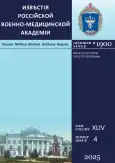Post-traumatic epilepsy as a consequence of gunshot penetrating head injury with intracranial metallic foreign body: epidemiology, prevention, and treatment algorithms
- 作者: Bazilevich S.N.1, Litvinenko I.V.1, Tsygan N.V.1, Odinak M.M.1, Prokudin M.Y.2
-
隶属关系:
- Military Medical Academy
- Medical Military Academy
- 期: 卷 44, 编号 4 (2025)
- 页面: 381-394
- 栏目: Conference Proceedings
- URL: https://journals.eco-vector.com/RMMArep/article/view/690186
- DOI: https://doi.org/10.17816/rmmar690186
- EDN: https://elibrary.ru/OXDPGH
- ID: 690186
如何引用文章
详细
BACKGROUND: The growing number of armed conflicts worldwide is leading to an increase in patients with combat-related traumatic brain injury, including those with intracranial metallic foreign bodies. Acute symptomatic post-traumatic epileptic seizures constitute a cause of secondary brain injury, whereas post-traumatic epilepsy may become the only disabling and quality-of-life-limiting consequence of head trauma, requiring prolonged antiseizure therapy.
AIM: This work aimed to investigate epidemiological features, diagnostic characteristics of epileptic seizures, and post-traumatic epilepsy in military personnel with intracranial metallic foreign bodies, and to evaluate algorithms for preventive antiseizure medication and treatment of post-traumatic epilepsy.
METHODS: A prospective study included 93 military personnel who sustained a gunshot penetrating head injury with an intracranial metallic foreign body. Patients were divided into two groups: group 1 (n = 63) with intracranial metallic foreign body retained; group 2 (n = 30) with intracranial metallic foreign body surgically removed within 4 months post-injury. To assess different approaches to preventive antiseizure therapy, both groups were subdivided into two subgroups: patients receiving prophylactic antiseizure medications (1a and 2a); patients without prophylactic antiseizure treatment (1b and 2b).
RESULTS: Post-traumatic epilepsy was diagnosed in 18 of 93 patients (19.4%). In group 1, a total of 13 patients (20.6%) developed epilepsy: 8 of 27 (29.6%) in subgroup 1a and 5 of 36 (13.9%) in subgroup 1b. In group 2, epilepsy occurred in 5 patients (16.7%): 4 of 16 (25%) in subgroup 2a and 1 of 14 (7.1%) in subgroup 2b. Among group 1 patients with post-traumatic epilepsy (n = 13), epileptiform activity on electroencephalogram was detected in 7 patients (53.8%), and paroxysmal slow-wave activity in 3 patients (23.1%). In subgroups, epileptiform activity was detected in 6 patients (22.2%) and paroxysmal slow-wave activity in 5 patients (18.5%) in 1a; and in 5 patients (13.9%) and 4 patients (11.1%) in 1b, respectively. Among subgroup 2a patients, epileptiform activity or paroxysmal slow-wave activity were detected in 8 of 16 patients (50%), with 4 patients demonstrating either pattern. In subgroup 2b, 13 of 14 patients demonstrated no epileptiform or paroxysmal slow-wave activity on electroencephalogram.
CONCLUSION: An intracranial metallic foreign body is a significant risk factor for post-traumatic epilepsy. The use of antiseizure medications for prophylaxis of epileptic seizures in this group of military personnel is not recommended. Paroxysmal slow-wave activity on electroencephalogram serves as a predictor of post-traumatic epilepsy and may guide preventive and therapeutic decision-making algorithms.
全文:
作者简介
Sergey Bazilevich
Military Medical Academy
编辑信件的主要联系方式.
Email: vmeda-nio@mil.ru
ORCID iD: 0000-0002-4248-9321
SPIN 代码: 9785-0471
MD, Cand. Sci. (Medicine)
俄罗斯联邦, Saint PetersburgIgor Litvinenko
Military Medical Academy
Email: vmeda-nio@mil.ru
ORCID iD: 0000-0001-8988-3011
SPIN 代码: 6112-2792
MD, Dr. Sci. (Medicine), Professor
俄罗斯联邦, Saint PetersburgNikolay Tsygan
Military Medical Academy
Email: vmeda-nio@mil.ru
ORCID iD: 0000-0002-5881-2242
SPIN 代码: 1006-2845
MD, Dr. Sci. (Medicine), Professor
俄罗斯联邦, Saint PetersburgMiroslav Odinak
Military Medical Academy
Email: vmeda-nio@mil.ru
ORCID iD: 0000-0002-7314-7711
SPIN 代码: 1155-9732
Corresponding Member of the Russian Academy of Sciences, MD, Dr. Sci. (Medicine), Professor
俄罗斯联邦, Saint PetersburgMikhail Prokudin
Medical Military Academy
Email: vmeda-nio@mil.ru
ORCID iD: 0000-0003-1545-8877
SPIN 代码: 4021-4432
MD, Cand. Sci. (Medicine)
俄罗斯联邦, Saint Petersburg参考
- Lauren CF Epidemiology of posttraumatic epilepsy: a critical review. Epilepsia. 2003;44(s10):11–17. doi: 10.1046/j.1528–1157.44.s10.4.x
- Carney N, Totten AM, O’Reilly C, et al. Guidelines for the Management of Severe Traumatic Brain Injury, Fourth Edition. Neurosurgery. 2017;80(1):6–15. doi: 10.1227/NEU.0000000000001432
- Odinak MM, Kornilov NV, Gritsanov AI, et al. Neuropathology of contusion-commotion injuries of world and war times. Gritsanov AI, ed. Saint Petersburg: MORSAR AV; 2000. 432 p. (In Russ.)
- Samokhvalov IM, ed. Military field surgery. National guidelines. 2nd ed., rev. and extra. Mоscоw: GEOTAR-Media Publ.; 2024. 1056 p. (In Russ.)
- Trishkin DV, Kryukov EV, Chuprina AP, et al. Methodological recommendations for the treatment of combat surgical injury. Moscow: Ministry of Defense of the Russian Federation Main Military Medical Department; 2022. 373 p. (In Russ.)
- Bazilevich SN, Litvinenko IV, Odinak MM, Tsygan NV. Epileptic seizures after the combat traumatic brain injury. The role and place of antiepileptic therapy. Russian Military Medical Academy Reports. 2024;43(4):377–392. doi: 10.17816/rmmar636870 EDN: VQDGPM
- Guseva EI, Konovalova AN Skvortsova VI, ed. Neurology: National guidelines. Moscow: GEOTAR-Media; 2018. 1064 p. (In Russ.)
- Tompson K, Pohlmann-Eden B, Campbell LA, Abel H. Pharmacological treatments for preventing epilepsy following traumatic head injury. Cochrane Database Syst Rev. 2015;2015(8):CD009900. doi: 10.1002/14651858.CD009900.pub2
- Odinak MM, ed. Military neurology: textbook. Saint Petersburg: VMedA; 2004. 356 p. (In Russ.)
- Lowenstein D. Epilepsy after head injury: An overview. Epilepsia. 2009:50 Suppl 2:4–9. doi: 10.1111/j.1528-1167.2008.02004.x
补充文件













